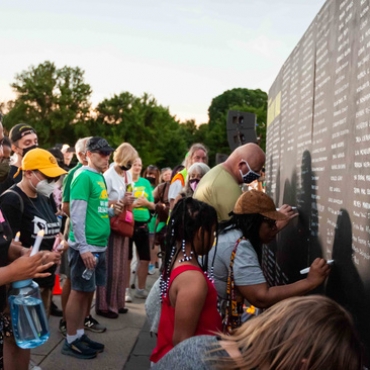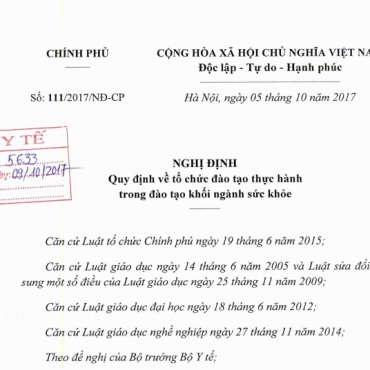Liên hệ tuyển sinh
Hợp tác Quốc tế
Precision Medicine for COVID-19 Phenotype Anarchy or Promise Realized?
Precision Medicine for COVID-19Phenotype Anarchy or Promise Realized?
Kimberley DeMerle, MD, MSc1; Derek C. Angus, MD, MPH1,2; Christopher W. Seymour, MD, MSc1,3
JAMA. Published online May 7, 2021. doi:10.1001/jama.2021.5248
Ataxonomic revolution is occurring in medicine. Spurred by the halcyon vision of targeted “precision” therapy and enabled by access to massive electronic health data sets, high-throughput multichannel, molecular diagnostic assays, and advances in the understanding of disease biology, researchers have generated a plethora of new disease subclassifications (eTable and eFigure in the Supplement). Variably termed “phenotypes,” “endotypes,” or “subtypes,” these patient groups can share symptoms, biology, or prognosis and are proposed as the basis for precision care.
The fast-paced research of SARS-CoV-2 has followed suit, with more than 60 subtypes proposed in the last year (eTable and eFigure in the Supplement). These subtypes range from simple classifications such as the H or L phenotypes of COVID-19–related acute respiratory distress syndrome to emerging groups organized from machine learning methods on large data sets. This Viewpoint examines the complexity of COVID-19 subtype classification and the implications for precision medicine.
Not All SARS-CoV-2 Is the Same
Subclassification of infectious diseases requires consideration of both the host and the pathogen. As recently shown, COVID-19 is not caused by a single, genetically identical RNA virus, but from an evolving pathogen with multiple mutations, lineages, and variants.1 These variants are identifiable through genetic sequencing and may have different effects on transmission, antigenicity, and virulence. SARS-CoV-2 variants may lead to different “RNA-emia” and organotropism, with interpatient variation in tissue sites involved.2
Emerging data suggest that some patients infected with a SARS-CoV-2 variant of concern (VOC) have an increased risk-adjusted odds of death compared with patients infected with SARS-CoV-2 that does not represent a VOC.3 Thus, some form of pathogen subclassification seems useful and probably necessary at least to understand disease spread, course, and prognosis. Notably, however, their relationships to vaccine-induced immunity, host response, immunopathology, and response to COVID-19 therapies are less clear.
Not All Hosts Are the Same
Patients also have a complex array of underlying risk and disease tolerance. For example, age and respiratory comorbidity, among other baseline factors, modify the risk of infection and outcome. The Genetics of Mortality in Critical Care study in the UK identified multiple genes associated with severe COVID-19, particularly those genes related to antiviral defense mechanisms and inflammatory organ damage.4 Host variability can also be described as differences in disease “tolerance.” As summarized by Medzhitov et al,5 disease tolerance is evolutionarily conserved, host defense mechanisms that do not rely on pathogen destruction. Tolerance differs at the organism, tissue, and cellular level, likely contributing to the disparate manifestations of COVID-19 among otherwise similar-appearing hosts.
The host also meets SARS-CoV-2 with varying degrees of immunity, in part due to prior infection, vaccination, or antibody prophylaxis and in part due to overall immune function. Thus, multiple predisposing host factors will affect disease susceptibility and course. What is less clear is whether these factors would influence the choice of therapy: would certain COVID-19 therapies be beneficial for patients with some predisposing factors and harmful for those with some others?
Not All Host Responses Are the Same
Once infected, the host has a dysregulated and variable response to SARS-CoV-2. This variable response could represent differences in the initial conditions of the host (different host preexisting conditions) or of the pathogen (different strain or inoculum size), as well as the consequences of differences in the timing of various treatments. Although an initial description characterized the response to COVID-19 as a so-called cytokine storm, it became evident that the magnitude of the innate immune response was variable and less than proposed.6 Circulating immune cell profiling revealed significant interpatient heterogeneity in major T-cell and B-cell populations, including a patient group with an absence of detectable lymphocyte response.7 These so-called immunophenotypes may connect to disease severity, but also maybe not.
Other pathobiologic mechanisms have also been described in COVID-19, including endothelial activation and abnormal coagulation. As the topology of the host response evolves, what is already clear is that downstream tissue injury is different for different hosts. Furthermore, viral RNA expression may or may not be correlated with local tissue inflammation and dysfunction.2 Consequently, for 2 patients with ongoing viral shedding, one may have minimal disease, while the other develops ongoing lung injury or thrombosis-related catastrophe.
What Is a Meaningful COVID Subtype?
Given the host-pathogen complexity, there may be thousands of potential subtypes of COVID-19. But the degree to which this COVID-19 diversification is relevant to bedside treatment is largely unknown. Subtype science must be more than just cataloguing COVID-19 heterogeneity, it should lead to specific therapies with improved patient outcomes. To date, most COVID-19 treatments use fairly imprecise subtyping. For example, glucocorticoids and IL-6 receptor antagonists appear beneficial in any hospitalized patient with some reasonable degree of oxygen support and inflammation, whereas anticoagulation may be better when initiated for patients with milder symptoms. Monoclonal antibodies seem beneficial for patients who are early in their disease course.
These subclassifications exist largely as a consequence of pragmatic clinical trial design decisions: it is difficult in a pandemic, rife with uncertainty, to launch sophisticated biomarker-guided “precision” trials. It may yet be true that some important subsets of hospitalized patients may benefit from monoclonal antibodies whereas other subsets of patients with less severe disease may benefit from earlier use of steroids or IL-6 receptor antagonists. Among patients for whom therapies are broadly indicated, there may also be subtypes who are at risk of harm. A lack of subtyping may have contributed to trials in which no benefit was demonstrated.
A Path to Realize Precision Treatment of COVID-19
The pursuit of precision COVID-19 treatment is already underway. Yet crude treatment assignment for select patients and number of proposed subtypes make progress appear disorganized and imprecise. Five essential criteria could help define COVID-19 subtypes: (1) biologically plausible, (2) promptly identifiable, (3) nonsynonymous, (4) reproducible, and, most important, (5) treatment responsive. The subtyping should consider clinical metadata, pathogen sequencing, and multi-omic readouts that inform not just COVID-19 prognosis, but treatment regimens.
Could there be a “living” COVID-19 taxonomy? Such cataloging of COVID-19 variants already occurs for genomic surveillance. A clearinghouse and review of meaningful subtypes could be administered by the World Health Organization, International Severe Acute Respiratory and Emerging Infection Consortium (ISARIC), or others, to reduce the anarchy of competitive lumping and splitting. The responsibilities of this taxonomic oversight could be to set the rules and to ensure that a common set of evaluation metrics exist for proposed subtypes.
A new COVID-19 taxonomy may also help promote the 5 essential subtype criteria.
-
Biological plausibility. A biological mechanism should underlie proposed subtypes, although biological plausibility depends on currently available knowledge. With COVID-19, this is rapidly evolving. Thus, plausibility is a moving target, difficult to define, and ranges from “suggested,” “hypothesized,” to “known.” An assessment of plausibility may be a top-down judgment, constrain the findings from unsupervised evaluation, but will also offer an initial determination of mechanistic plausibility (DMP). The DMP is not a final rule, but a contemporary starting point for whether subtypes merit further consideration during a pandemic.
-
Promptly identifiable. The COVID-19 taxonomy should track the methodologic steps necessary to learn the subtype. Are data or tests required for subtype determination that are routinely available in clinical practice (eg, lymphocyte count, C-reactive protein), or require advanced measurement techniques? Such practical steps are key to understanding the scalability of subtype measurement at both low and high resource settings.
-
Nonsynonymous. Subtype proposals should not identify the same patients. A COVID-19 taxonomy should use a common data model to determine whether subtypes are actually labeling similar patients. Then, ongoing international collaborations sharing COVID-19 data could empirically test at the patient level whether overlap is present.
-
Reproducible. Subtypes should be reproducible in similar patients derived from separate data sets. They may even be generalizable across regions or sparseness of data. These analyses could be promoted through a COVID-19 taxonomy and the shared common data model.
-
Treatment responsive. A catalogue of observational studies and randomized trials is required to understand how meaningful COVID-19 subtypes could lead to precision treatment. This will help expand the taxonomy beyond just subtypes, but also include the many studies in which they could be interrogated. For example, randomized trials that use adaptive designs can prospectively learn, discard, or enrich for subtype-specific treatment effects. Observational studies of COVID-19 therapies can be investigated using mediation analysis. These data also could be combined. For example, new statistical methods can search for and identify confounders and effect modifiers in data from clinical settings, confirm the causal structure in randomized trial data, and then model subtype-specific treatment policies.
Most important, the path to precision medicine in COVID-19 requires an incredibly rapid pace. Other examples like the Cancer Moonshot, the Precision Medicine Initiative, and the All of Us Research Program may lead to important breakthroughs for thousands of patients, but after many years of investment. The time is now for an effective precision medicine approach for COVID-19 that joins translational science, subtype discovery, and a new taxonomy with knowledge generation in clinical trials.Corresponding Author: Christopher W. Seymour, MD, MSc, Clinical Research, Investigation, and Systems Modeling of Acute illness (CRISMA) Center, Departments of Critical Care Medicine and Emergency Medicine, University of Pittsburgh School of Medicine, 3550 Terrace St, Scaife Hall, #639, Pittsburgh, PA 15261 (seymourcw@upmc.edu).
Published Online: May 7, 2021. doi:10.1001/jama.2021.5248
Conflict of Interest Disclosures: Dr Angus reports receiving grants from University of Pittsburgh REMAP-CAP and grants from Amgen and Eisai. Dr Seymour reports receiving grants from NIH, personal fees from Beckman Coulter, nonfinancial support from Amgen, and nonfinancial support from Eisai. No other disclosures were reported.
Funding/Support: This work was funded in part by the NIH (Dr Seymour, R35GM119519).
Role of the Funder/Sponsor: The NIH had no role in the preparation, review, or approval of the manuscript; and decision to submit the manuscript for publication.
Additional Contributions: We acknowledge the thoughtful review and input from Manu Shankar-Hari, MD, MSc, PhD (King’s College London and St Thomas’ Hospital) and Kenneth Baillie, MBChB (University of Edinburgh).
References
1.Lauring AS, Hodcroft EB. Genetic variants of SARS-CoV-2: what do they mean? JAMA. 2021;325(6):529-531. doi:10.1001/jama.2020.27124
ArticlePubMedGoogle ScholarCrossref
2.Dorward DA, Russell CD, Um IH, et al. Tissue-specific immunopathology in fatal COVID-19. Am J Respir Crit Care Med. 2021;203(2):192-201.PubMedGoogle ScholarCrossref
3.Challen R, Brooks-Pollock E, Read JM, et al. Risk of mortality in patients infected with SARS-CoV-2 variant of concern 202012/1. BMJ. 2021;372(n579):n579. doi:10.1136/bmj.n579PubMedGoogle ScholarCrossref
4.Pairo-Castineira E, Clohisey S, Klaric L, et al. Genetic mechanisms of critical illness in COVID-19. Nature. 2021;591(7848):92-98. doi:10.1038/s41586-020-03065-yPubMedGoogle ScholarCrossref
5.Medzhitov R, Schneider DS, Soares MP. Disease tolerance as a defense strategy. Science. 2012;335(6071):936-941. doi:10.1126/science.1214935PubMedGoogle ScholarCrossref
6.Kox M, Waalders NJB, Kooistra EJ, Gerretsen J, Pickkers P. Cytokine levels in critically ill patients with COVID-19 and other conditions. JAMA. 2020;324(15):1565–1567. doi:10.1001/jama.2020.17052
ArticlePubMedGoogle ScholarCrossref
7.Mathew D, Giles JR, Baxter AE, et al; UPenn COVID Processing Unit. Deep immune profiling of COVID-19 patients reveals distinct immunotypes with therapeutic implications. Science. 2020;369(6508):eabc8511. doi:10.1126/science.abc8511PubMedGoogle Scholar
Source: https://jamanetwork.com/journals/jama/fullarticle/2779924?guestAccessKey=8ee361c0-866f-4030-8087-b3fa3b8b1a3a&utm_source=silverchair&utm_campaign=jama_network&utm_content=covid_weekly_highlights&utm_medium=email
Các tin khác
- One in 10 People Who Had Omicron Got Long COVID: Study ( 20:25 - 01/06/2023 )
- Physical Medicine Academy Issues Guidance on Long COVID Neurologic Symptoms ( 09:58 - 19/05/2023 )
- SARS-CoV-2 đi qua nhau thai và lây nhiễm não của hai trẻ sơ sinh: “Đây là trường hợp đầu tiên” ( 16:55 - 10/04/2023 )
- Breakthrough' Study: Diabetes Drug Helps Prevent Long COVID ( 08:55 - 15/03/2023 )
- BCG vaccine (thuốc chủng ngừa bệnh lao) & SARS-CoV 2 (covid-19) infection ( 10:08 - 27/10/2022 )
- Đại dịch COVID-19 đã kết thúc? ( 09:11 - 22/09/2022 )
- Dị hình giới tính ở COVID-19: Ý nghĩa tiềm năng về lâm sàng và sức khỏe cộng đồng ( 09:22 - 19/03/2022 )
- COVID-19 Update ( 21:00 - 06/03/2022 )
- Một người có thể tái mắc Covid-19 bao nhiêu lần ?? ( 20:25 - 06/03/2022 )
- T-cells from common colds can provide protection against COVID-19 - study ( 08:25 - 11/01/2022 )














